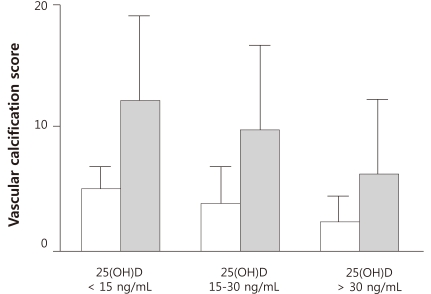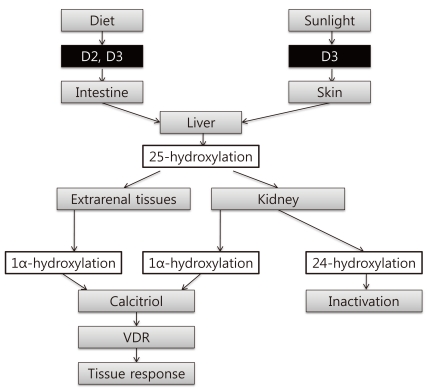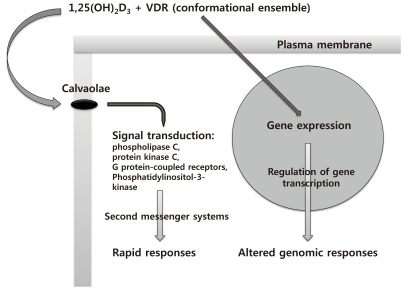Electrolyte Blood Press.
2011 Jun;9(1):1-6. 10.5049/EBP.2011.9.1.1.
Vitamin D, and Kidney Disease
- Affiliations
-
- 1Department of Internal Medicine, Gachon University of Medicine and Science, Incheon, Korea. imsejoong@daum.net
- KMID: 1497135
- DOI: http://doi.org/10.5049/EBP.2011.9.1.1
Abstract
- Mineral metabolism abnormalities, such as low 1,25-dihydroxyvitamin D (1,25(OH)2D) and elevated parathyroid hormone (PTH), are common at even higher glomerular filtration rate than previously described. Levels of 25-hydroxyvitamin D (25(OH)D) show an inverse correlation with those of intact PTH and phosphorus. Studies of the general population found much higher all-cause and cardiovascular (CV) mortality for patients with lower levels of vitamin D; this finding suggests that low 25(OH)D level is a risk factor and predictive of CV events in patients without chronic kidney disease (CKD). 25(OH)D/1,25(OH)2D becomes deficient with progression of CKD. Additionally, studies of dialysis patients have found an association of vitamin D deficiency with increased mortality. Restoration of the physiology of vitamin D receptor activation should be essential therapy for CKD patients.
Keyword
MeSH Terms
Figure
Reference
-
1. Norman AW, Bouillon R. Vitamin D nutritional policy needs a vision for the future. Exp Biol Med (Maywood). 2010; 235:1034–1045. PMID: 20667908.
Article2. Zittermann A, Schleithoff SS, Koerfer R. Putting cardiovascular disease and vitamin D insufficiency into perspective. Br J Nutr. 2005; 94:483–492. PMID: 16197570.
Article3. Choi N. Kidney and phosphate metabolism. Electrolyte Blood Press. 2008; 6:77–85.
Article4. Bergwitz C, Juppner H. Regulation of phosphate homeostasis by PTH, vitamin D, and FGF23. Annu Rev Med. 2010; 61:91–104. PMID: 20059333.
Article5. Garcia-Canton C, Bosch E, Ramirez A, et al. Vascular calcification and 25-hydroxyvitamin D levels in non-dialysis patients with chronic kidney disease stages 4 and 5. Nephrol Dial Transplant. 2011; 26:2250–2256. PMID: 20956810.
Article6. Adragao T, Pires A, Lucas C, et al. A simple vascular calcification score predicts cardiovascular risk in haemodialysis patients. Nephrol Dial Transplant. 2004; 19:1480–1488. PMID: 15034154.
Article7. Kauppila LI, Polak JF, Cupples LA, Hannan MT, Kiel DP, Wilson PW. New indices to classify location, severity and progression of calcific lesions in the abdominal aorta: a 25-year follow-up study. Atherosclerosis. 1997; 132:245–250. PMID: 9242971.
Article8. Razzaque MS. The dualistic role of vitamin D in vascular calcifications. Kidney Int. 2011; 79:708–714. PMID: 20962746.
Article9. Maalouf NM. The noncalciotropic actions of vitamin D: recent clinical developments. Curr Opin Nephrol Hypertens. 2008; 17:408–415. PMID: 18660678.
Article10. Motiwala SR, Wang TJ. Vitamin D and cardiovascular disease. Curr Opin Nephrol Hypertens. 2011; 20:345–353. PMID: 21519252.
Article11. Henry HL, Bouillon R, Norman AW, et al. 14th Vitamin D Workshop consensus on vitamin D nutritional guidelines. J Steroid Biochem Mol Biol. 2010; 121:4–6. PMID: 20561983.
Article12. Forrest KY, Stuhldreher WL. Prevalence and correlates of vitamin D deficiency in US adults. Nutr Res. 2011; 31:48–54. PMID: 21310306.
Article13. Hintzpeter B, Mensink GB, Thierfelder W, Muller MJ, Scheidt-Nave C. Vitamin D status and health correlates among German adults. Eur J Clin Nutr. 2008; 62:1079–1089. PMID: 17538533.
Article14. Rockell JE, Skeaff CM, Williams SM, Green TJ. Serum 25-hydroxyvitamin D concentrations of New Zealanders aged 15 years and older. Osteoporos Int. 2006; 17:1382–1389. PMID: 16832715.
Article15. Choi HS, Oh HJ, Choi H, et al. Vitamin D insufficiency in Korea--a greater threat to younger generation: the Korea National Health and Nutrition Examination Survey (KNHANES) 2008. J Clin Endocrinol Metab. 2011; 96:643–651. PMID: 21190984.
Article16. Levin A, Bakris GL, Molitch M, et al. Prevalence of abnormal serum vitamin D, PTH, calcium, and phosphorus in patients with chronic kidney disease: results of the study to evaluate early kidney disease. Kidney Int. 2007; 71:31–38. PMID: 17091124.
Article17. Evenepoel P, Meijers B, Viaene L, et al. Fibroblast growth factor-23 in early chronic kidney disease: additional support in favor of a phosphate-centric paradigm for the pathogenesis of secondary hyperparathyroidism. Clin J Am Soc Nephrol. 2010; 5:1268–1276. PMID: 20448073.
Article18. Lee YM, Park SW, Kim JS, et al. 25-Hydroxyvitamin D status in patients with chronic kidney disease in a single center. Korean J Nephrol. 2010; 29:458–464.19. Kidney Disease: Improving Global Outcomes (KDIGO) CKD-MBD Work Group. KDIGO clinical practice guideline for the diagnosis, evaluation, prevention, and treatment of Chronic Kidney Disease-Mineral and Bone Disorder (CKD-MBD). Kidney Int Suppl. 2009; (113):S1–S130.20. Melamed ML, Michos ED, Post W, Astor B. 25-hydroxyvitamin D levels and the risk of mortality in the general population. Arch Intern Med. 2008; 168:1629–1637. PMID: 18695076.
Article21. Dobnig H, Pilz S, Scharnagl H, et al. Independent association of low serum 25-hydroxyvitamin d and 1,25-dihydroxyvitamin d levels with all-cause and cardiovascular mortality. Arch Intern Med. 2008; 168:1340–1349. PMID: 18574092.
Article22. Autier P, Gandini S. Vitamin D supplementation and total mortality: a meta-analysis of randomized controlled trials. Arch Intern Med. 2007; 167:1730–1737. PMID: 17846391.23. Kandula P, Dobre M, Schold JD, Schreiber MJ Jr, Mehrotra R, Navaneethan SD. Vitamin D supplementation in chronic kidney disease: a systematic review and meta-analysis of observational studies and randomized controlled trials. Clin J Am Soc Nephrol. 2011; 6:50–62. PMID: 20876671.
Article24. Kovesdy CP, Ahmadzadeh S, Anderson JE, Kalantar-Zadeh K. Association of activated vitamin D treatment and mortality in chronic kidney disease. Arch Intern Med. 2008; 168:397–403. PMID: 18299495.
Article25. Drechsler C, Verduijn M, Pilz S, et al. Vitamin D status and clinical outcomes in incident dialysis patients: results from the NECOSAD study. Nephrol Dial Transplant. 2011; 26:1024–1032. PMID: 20947538.
Article
- Full Text Links
- Actions
-
Cited
- CITED
-
- Close
- Share
- Similar articles
-
- Vitamin D and chronic kidney disease
- Vitamin D Deficiency and Cognitive Dysfunction
- Vitamin D and Allergic Disease
- Change in Plasma Homocysteine Concentration during the Recovery Phase of Renal Transplantation
- Early posttransplant vitamin D improvement is associated with better long-term kidney graft survival




